The States and Properties of Germanium in Sulfuric Acid Solution
Abstract
1. Introduction
2. Materials and Methods
2.1. Experimental Design
2.2. Testing Equipment
3. Results and Discussion
3.1. The States of Germanium
3.1.1. E–pH Diagram Simulation
3.1.2. Raman Spectra Analysis
3.1.3. FTIR Spectra Analysis
3.1.4. XPS Spectroscopy Analysis
3.2. The States of Germanium
3.2.1. Tyndall Phenomenon of Germanium Solution
3.2.2. Nanoparticle Size and Zeta Potential
4. Conclusions
Author Contributions
Funding
Institutional Review Board Statement
Informed Consent Statement
Data Availability Statement
Conflicts of Interest
References
- Kaji, M. DI Mendeleev’s concept of chemical elements and the principles of chemistry. Bull. Hist. Chem. 2002, 27, 4–16. [Google Scholar]
- Depuydt, B.; Theuwis, A.; Romandic, I. Germanium: From the first application of Czochralski crystal growth to large diameter dislocation-free wafers. Mater. Sci. Semicond. Process. 2006, 9, 437–443. [Google Scholar] [CrossRef]
- Hu, R.Z.; Su, W.C.; Qi, H.W.; Bi, X.W. Geochemistry, occurrence and mineralization of germanium. Bull. Mineral. Petrol. Geochem. 2000, 19, 215–217. [Google Scholar]
- Zhang, M.; Gu, X.; Fu, S.; Si, R.; Li, F. A Review of Disperse Element Germanium. Bull. Mineral. Petrol. Geochem. 2003, 1, 82–87. [Google Scholar]
- Dass, D. Effects of surface passivation by hydrogen on the structural and electronic properties of a germanium nanowire: A sp3 tight binding study. Appl. Surf. Sci. 2019, 488, 404–417. [Google Scholar] [CrossRef]
- Zhang, X.; Bu, Z.; Lin, S.; Chen, Z.; Li, W.; Pei, Y. GeTe thermoelectrics. Joule 2020, 4, 986–1003. [Google Scholar] [CrossRef]
- Huang, T.; Cao, Q.; Jing, B.; Wang, X.; Wang, D.; Liang, L. Towards high-performance lithium-sulfur battery: Investigation on the capability of metalloid to regulate polysulfides. Chem. Eng. J. 2022, 430, 132677. [Google Scholar] [CrossRef]
- Wang, P.; Chen, L.Y.; Ge, J.P.; Cai, W.; Chen, W.Q. Incorporating critical material cycles into metal-energy nexus of China’s 2050 renewable transition. Appl. Energy 2019, 253, 113612. [Google Scholar] [CrossRef]
- Chen, X.; Qu, J.; Zhang, Y.; Wu, L.; Wang, L. Analysis of the global germanium resource supply and demand situation from 2021 to 2035. China Min. Mag. 2021, 30, 37–42. [Google Scholar]
- Wang, J.; He, A. Xiandai Zhe Yejin; Metallurgical Industry Press: Beijing, China, 2005. [Google Scholar]
- Shen, Z.; Cai, S.; Zhao, J. Current Situation and Sustainable Development Suggestions of Germanium Resources in China. Min. Res. Dev. 2015, 35, 108–112. [Google Scholar]
- Gu, L. Experimental study on increasing germanium leaching rate from zinc oxide dust. China Min. Mag. 2020, 29 (Suppl. S1), 419–421+424. [Google Scholar]
- Höll, R.; Kling, M.; Schroll, E. Metallogenesis of germanium—A review. Ore Geol. Rev. 2007, 30, 145–180. [Google Scholar] [CrossRef]
- Li, W. The Recovery of Germanium from the Pb and Zn Sulfide Concentrate. Master’s Thesis, Central South University, Changsha, China, 2004. [Google Scholar]
- Bernstein, L.R.; Waychunas, G.A. Germanium crystal chemistry in hematite and goethite from the Apex Mine, Utah, and some new data on germanium in aqueous solution and in stottite. Geochim. Cosmochim. Acta 1987, 51, 623–630. [Google Scholar] [CrossRef]
- Hu, R.Z.; Bi, X.W.; Su, W.C.; Ye, Z.J. Some considerations on germanium mineralization in coal-as exemplified by Lincang germanium deposit. Acta Miner. Sin. 1997, 4, 364–368. [Google Scholar]
- Li, J.; Zhuang, X.; Querol, X. Trace element affinities in two high-Ge coals from China. Fuel 2011, 90, 240–247. [Google Scholar] [CrossRef]
- Hu, R.Z.; Qi, H.W.; Zhou, M.F.; Su, W.C.; Bi, X.W.; Peng, J.T.; Zhong, H. Geological and geochemical constraints on the origin of the giant Lincang coal seam-hosted germanium deposit, Yunnan, SW China: A review. Ore Geol. Rev. 2009, 36, 221–234. [Google Scholar] [CrossRef]
- Geng, X.; Liu, Y.; Zhang, W.; Wang, L.; Wen, J.; Sun, J. Recent advances in the recovery of germanium during the zinc refining process. Chem. Eng. J. 2022, 446, 137445. [Google Scholar] [CrossRef]
- Marchon, B.; Cote, G.; Bauer, D. Some typical behaviours of the β-dodecenyl 8-hydroxyquinoline through its reactions with germanium (IV). J. Inorg. Nucl. Chem. 1979, 41, 1353–1363. [Google Scholar] [CrossRef]
- Nazarenko, V.A.; Andrianov, A.M. Complex compounds of germanium and its state in solution. Russ. Chem. Rev. 1965, 34, 547. [Google Scholar] [CrossRef]
- Pokrovski, G.S.; Schott, J. Thermodynamic properties of aqueous Ge (IV) hydroxide complexes from 25 to 350 C: Implications for the behavior of germanium and the Ge/Si ratio in hydrothermal fluids. Geochimica Cosmochimica Acta 1998, 62, 1631–1642. [Google Scholar] [CrossRef]
- Wang, Z. Dictionary of Chemical Technology; Chemical Industry Press: Beijing, China, 1992. [Google Scholar]
- Liu, C.X.; Wang, J.K.; Shen, Q.F. Electrochemical behavior of germanium in zinc deposition from acidic electrolytes. Chin. J. Nonferrous Met. 2009, 19, 1690–1694. [Google Scholar]
- Arai, K. Observation of chemical reaction and liquid structure of S Ge by Raman spectroscopy. J. Non Cryst. Solids 1983, 59, 1059–1062. [Google Scholar] [CrossRef]
- Volodin, V.A.; Krivyakin, G.K.; Ivlev, G.D.; Prokopyev, S.L.; Gusakova, S.V.; Popov, A.A.E. Crystallization of amorphous germanium films and multilayer a-Ge/a-Si structures upon exposure to nanosecond laser radiation. Semiconductors 2019, 53, 400–405. [Google Scholar] [CrossRef]
- Bermejo, D.; Cardona, M. Raman scattering in pure and hydrogenated amorphous germanium and silicon. J. Non Cryst. Solids 1979, 32, 405–419. [Google Scholar] [CrossRef]
- Henderson, G.S. The Germanate Anomaly: What do we know? J. Non Cryst. Solids 2007, 353, 1695–1704. [Google Scholar] [CrossRef]
- Tominaga, Y. Raman Scattering of Liquid Water and Hydrogen-Bonded Cluster. Nihon Kessho Gakkaishi 1998, 40, 95–100. [Google Scholar] [CrossRef]
- Eom, H.J.; Gupta, D.; Cho, H.R.; Hwang, H.J.; Hur, S.D.; Gim, Y.; Ro, C.U. Single–particle investigation of summertime and wintertime Antarctic sea spray aerosols using low-Z particle EPMA, Raman microspectrometry, and ATR-FTIR imaging techniques. Atmos. Chem. Phys. 2016, 16, 13823–13836. [Google Scholar] [CrossRef]
- Choi, S.; Han, S.; Hwang, S. Defect-related photoluminescence and Raman studies on the growth of Ge nanocrystals during annealing of Ge+-implanted SiO2 films. Thin Solid Film. 2002, 413, 177–180. [Google Scholar] [CrossRef]
- Fujii, M.; Hayashi, S.; Yamamoto, K. Raman scattering from quantum dots of Ge embedded in SiO2 thin films. Appl. Phys. Lett. 1990, 57, 2692–2694. [Google Scholar] [CrossRef]
- Men, D.; Xiao, W.; Ye, X.; Hua, W. Structure and Raman scattering of nanocrystalline germanium thin films. J. Guangdong Non Ferr. Met. 2005, 15, 22–25. [Google Scholar]
- Verweij, H.; Buster, J. The structure of lithium, sodium and potassium Germanate glasses, studied by Raman scattering. J. Non Cryst. Solids 1979, 34, 81–99. [Google Scholar] [CrossRef]
- Hosono, H.; Abe, Y. Temperature dependence of infrared absorption spectra of hydroxyl groups in soda Germanate glasses. J. Am. Ceram. Soc. 1989, 72, 44–48. [Google Scholar] [CrossRef]
- Saikia, B.J.; Parthasarathy, G. Fourier transform infrared spectroscopic characterization of kaolinite from Assam and Meghalaya. Northeast. India J. Mod. Phys. 2010, 1, 206–210. [Google Scholar]
- Ma, G.; Liu, Y.; Peng, T.; Wu, W.; Ji, G. Preparation and characterizion of the Ni[Ge2O5](OH)4 Nanodisk. J. Sichuan Univ. Nat. Sci. Ed. 2013, 50, 590–594. [Google Scholar]
- Liu, S.; Jia, L.; Xu, Y.; Tsona, N.T.; Ge, S.; Du, L. Photooxidation of cyclohexene in the presence of SO2: SOA yield and chemical composition. Atmos. Chem. Phys. 2017, 17, 13329–13343. [Google Scholar] [CrossRef]
- Nelis, A.; Haye, E.; Terwagne, G. Influence of oxygen co-implantation on germanium out-diffusion and nanoclustering in SiO2/Si films. Thin Solid Film 2022, 746, 139135. [Google Scholar] [CrossRef]
- Gautam, C.R.; Das, S.; Gautam, S.S.; Madheshiya, A.; Singh, A.K. Processing and optical characterization of lead calcium titanate borosilicate glass doped with germanium. J. Phys. Chem. Solids 2018, 115, 180–186. [Google Scholar] [CrossRef]
- Najafov, B.A.; Figarov, V.R. Solar energy converters based on a-Si0. 80 Ge0. 20: H films. Int. J. Sustain. Energy 2007, 26, 149–155. [Google Scholar] [CrossRef]
- Nekić, N.; Šarić, I.; Salamon, K.; Basioli, L.; Sancho-Parramon, J.; Grenzer, J.; Hübner, R.; Bernstorff, S.; Petravić, M.; Mičetić, M. Preparation of non-oxidized Ge quantum dot lattices in amorphous Al2O3, Si3N4 and SiC matrices. Nanotechnology 2019, 30, 335601. [Google Scholar] [CrossRef]
- Lam, D.; Chen, K.S.; Kang, J.; Liu, X.; Hersam, M.C. Anhydrous liquid-phase exfoliation of pristine electrochemically active GeS nanosheets. Chem. Mater. 2018, 30, 2245–2250. [Google Scholar] [CrossRef]
- Mirabella, F.; Johnson, R.L.; Ghijsen, J. Photoemission investigations of manganese thin films deposited on GeS (001) surfaces. Surf. Sci. 2002, 506, 172–182. [Google Scholar] [CrossRef]
- Yang, G.; Yang, C.; Hu, D.; Peng, C.; Tang, K.; Lu, Y.; Tang, F.; He, X.; Xu, Y. Effect of halogen on imprinting gradient refractive index microstructure in GeS2–Ga2S3–NaX (X = F, Cl, Br, I) glasses for broadband infrared diffraction gratings. Ceram. Int. 2021, 47, 28511–28520. [Google Scholar] [CrossRef]
- Hollinger, G.; Kumurdjian, P.; Mackowski, J.M.; Pertosa, P.; Porte, L.; Duc, T.M. ESCA study of molecular GeS3−x Tex As2 glasses. J. Electron Spectrosc. Relat. Phenom. 1974, 5, 237–245. [Google Scholar] [CrossRef]
- Gopalakrishnan, R.; Chowdari, B.V.R.; Tan, K.L. Properties and structure of Pb Ge O F glasses. Solid State Ion. 1992, 51, 203–208. [Google Scholar] [CrossRef]
- Sabharwal, S.C.; Jha, S.N. Optical and X-ray photoelectron spectroscopy of PbGeO3 and Pb5Ge3O11 single crystals. Bull. Mater. Sci. 2010, 33, 395–400. [Google Scholar] [CrossRef]
- Dolado, J.; Hidalgo, P.; Méndez, B. Correlative study of vibrational and luminescence properties of Zn2GeO4 microrods. Phys. Status Solidi A 2018, 215, 1800270. [Google Scholar] [CrossRef]
- Zhang, Z.; Ge, X.; Zhang, X.; Duan, L.; Li, X.; Yang, Y.; Lü, W. A sea cucumber-like BiOBr nanosheet/Zn2GeO4 nanorod heterostructure for enhanced visible light driven photocatalytic activity. Mater. Res. Express 2018, 5, 015009. [Google Scholar] [CrossRef]
- Zhou, J.; Zhang, W.; Zhao, H.; Tian, J.; Zhu, Z.; Lin, N.; Qian, Y. Growth of bouquet-like Zn2GeO4 crystal clusters in molten salt and understanding the fast Na-storage properties. ACS Appl. Mater. Interfaces 2019, 11, 22371–22379. [Google Scholar] [CrossRef]
- Gabrelian, B.V.; Lavrentyev, A.A.; Vu, T.V.; Tkach, V.A.; Marchuk, O.V.; Kalmykova, K.F.; Ananchenko, L.N.; Parasyuk, O.V.; Khyzhun, O.Y. Quaternary Cu2HgGeSe4 selenide: Its electronic and optical properties as elucidated from TB-mBJ band-structure calculations and XPS and XES measurements. Chem. Phys. 2020, 536, 110821. [Google Scholar] [CrossRef]
- Kwon, M.; Han, S.; Ryu, J.H.; Lee, C.; Lee, Y.Y.; Kim, B.H. Characteristics of SiGe Oxidation and Ge Loss according to Ge Content. In Proceedings of the 2020 31st Annual SEMI Advanced Semiconductor Manufacturing Conference (ASMC), Saratoga Springs, NY, USA, 24–26 August 2020; IEEE: Piscataway, NJ, USA, 2020; pp. 1–4. [Google Scholar]
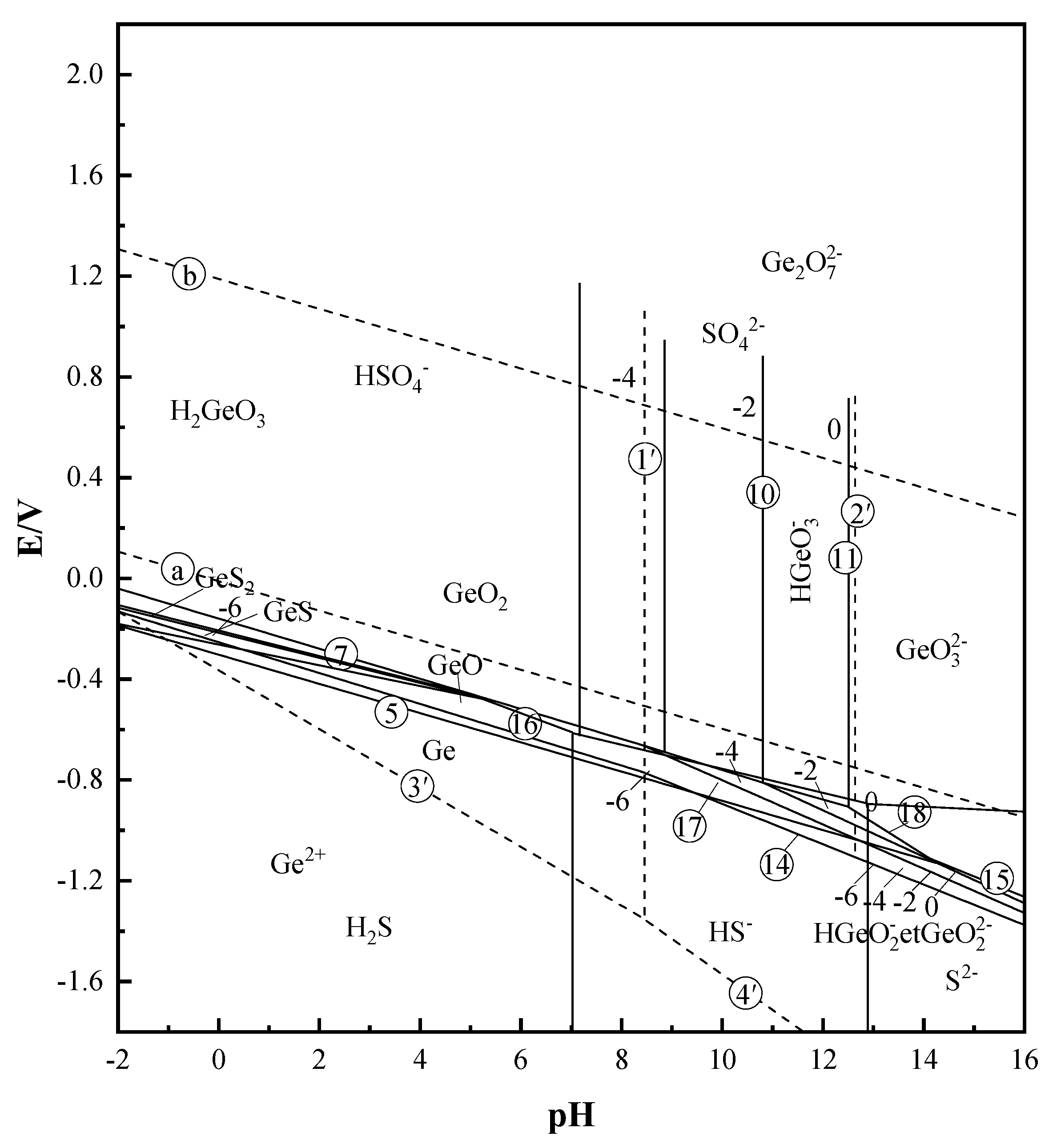
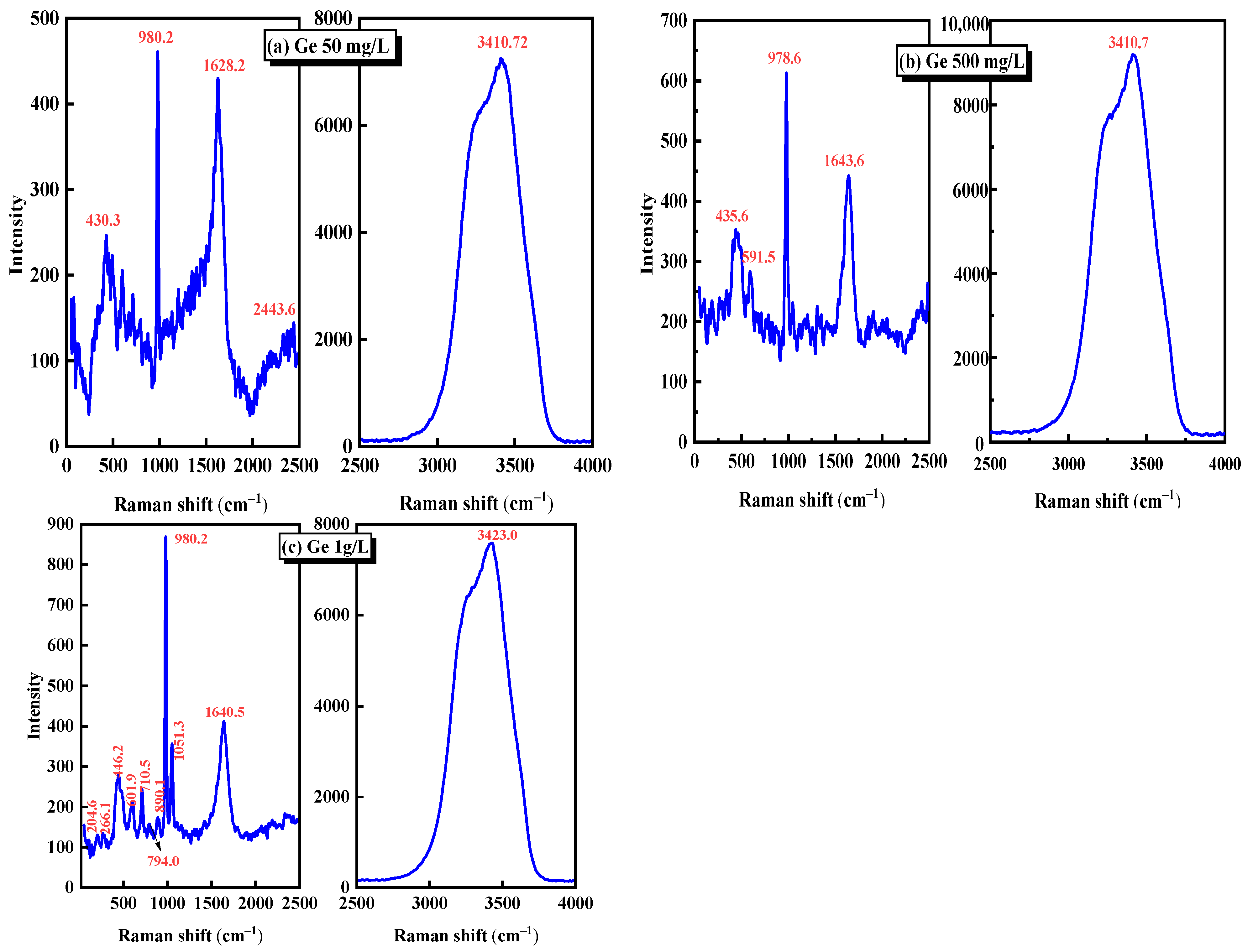

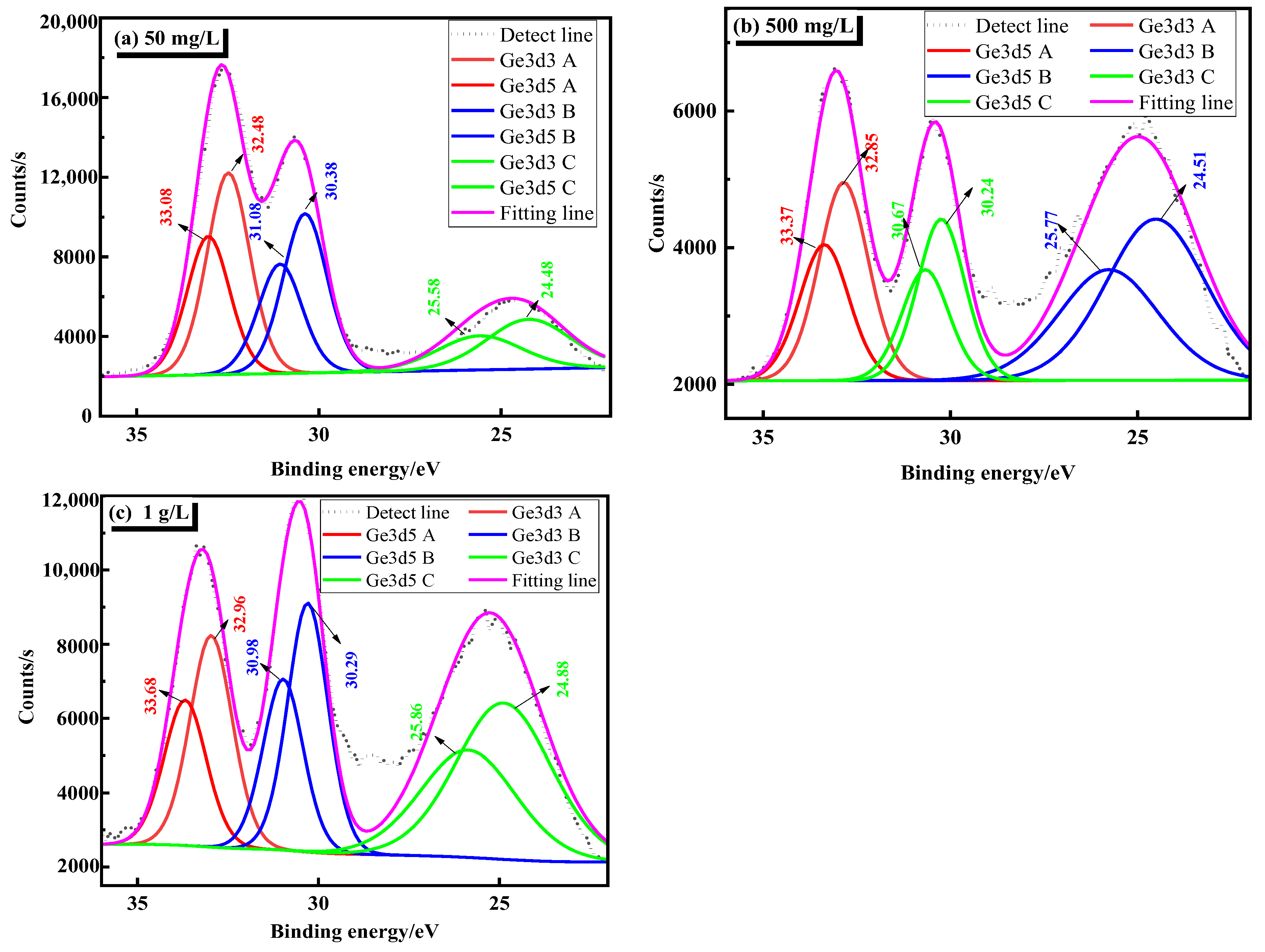
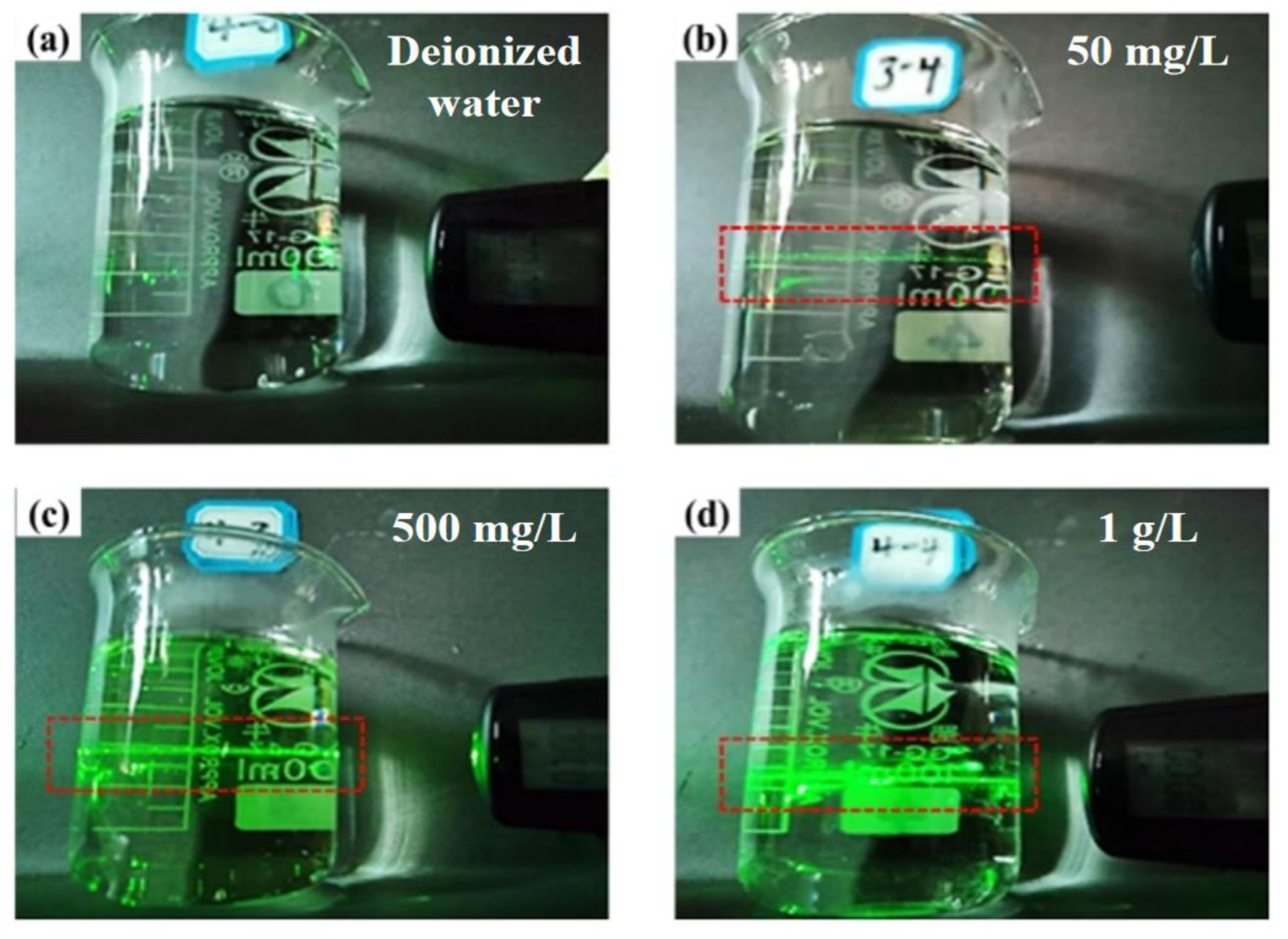
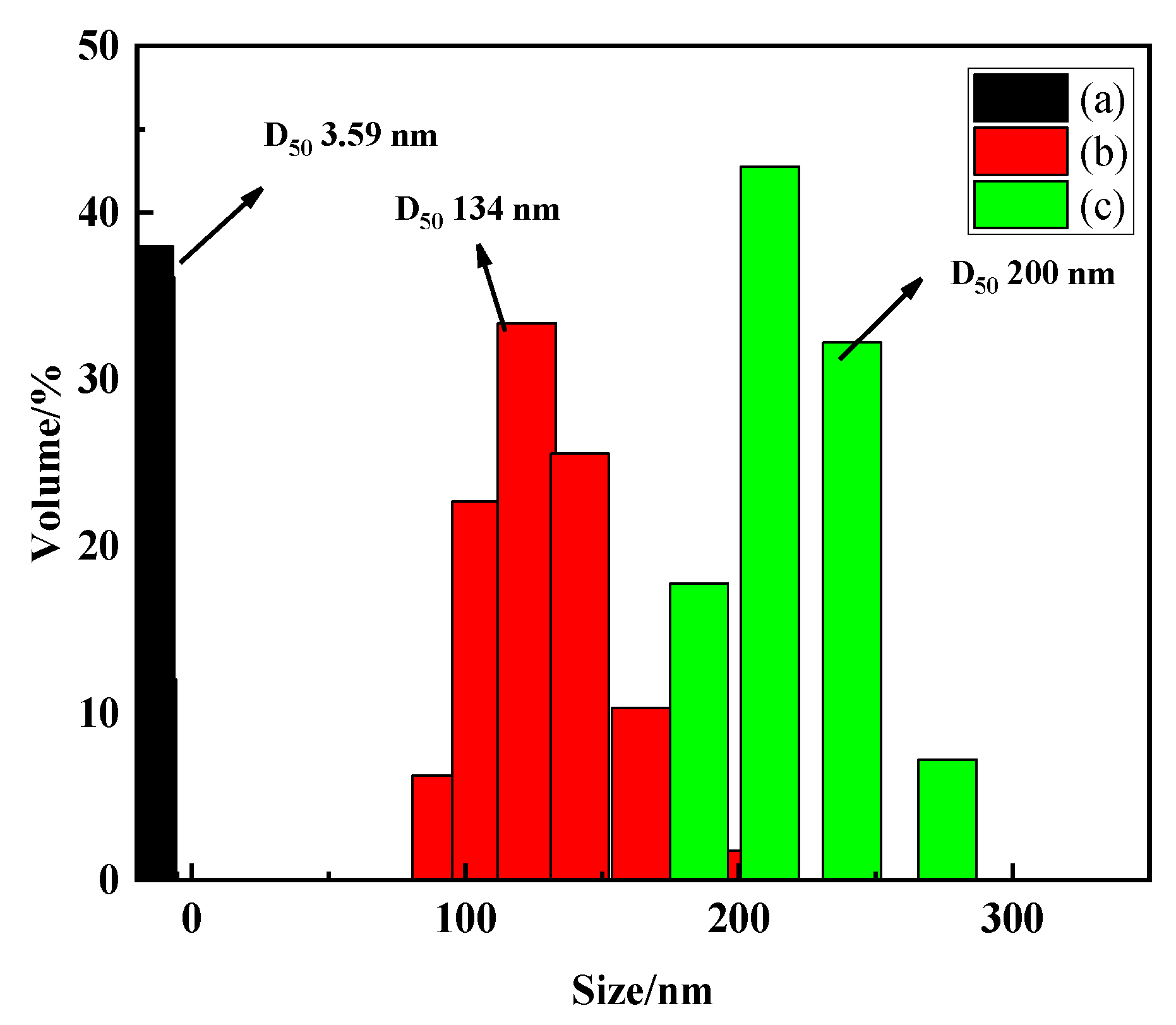

| Number | Reaction Equation | Equilibrium Equation |
|---|---|---|
| 1 | H2GeO3 = HGeO3− + H+ | |
| 2 | HGeO3− = GeO32−+ H+ | |
| 3 | Ge2+ + 3H2O = H2GeO3 + 4H+ +2e− | |
| 4 | Ge2+ + 3H2O = HGeO3− + 5H+ +2e− | |
| 5 | Ge + H2O = GeO + 2H+ +2e− | |
| 6 | Ge + 2H2O = GeO2 + 4H+ +4e− | |
| 7 | GeO + H2O = GeO2 + 2H+ +2e− | |
| 8 | Ge2+ +H2O = GeO + 2H+ | |
| 9 | GeO2 + H2O = H2GeO3 | |
| 10 | GeO2 + H2O = HGeO3− + H+ | |
| 11 | GeO2 + H2O = GeO32−+ 2H+ | |
| 12 | Ge = Ge2+ +2e− | |
| 13 | Ge + 3H2O = H2GeO3 + 4H+ +4e− | |
| 14 | Ge + 3H2O = HGeO3− + 5H+ +4e− | |
| 15 | Ge + 3H2O = GeO32−+ 6H+ +4e− | |
| 16 | GeO + 2H2O = H2GeO3 + 2H+ +2e− | |
| 17 | GeO + 2H2O = HGeO3− + 3H+ +2e− | |
| 18 | GeO + 2H2O = GeO32− + 4H+ +2e− |
| Type | Characteristic Peak |
|---|---|
| Vibrational scattering of Ge–S bond | 385–430 |
| Ge–H bond vibration | 1890–2000 |
| Symmetric stretching vibration of five–coordinated germanium non-bridge oxygen | 700–1000 |
| Ge–O bond vibration | 215, 650 |
| The stretching vibration of Ge–O–Ge bond | 800 |
| Vibration of Six-Coordination Germanium Bridged Oxygen | 600–700 |
| Type | IR Frequency | ||
|---|---|---|---|
| Extensional Vibration | Bending Vibration | Asymmetric Stretching Vibration | |
| Ge–OH | 3300–3450 | ||
| Ge–O | 643 (700–900) | 714 | 629.5 |
| Ge–H | 1980 | ||
| Ge–O–Ge | 870 (700–900) | 566 (500–700) | 857 (700–900) |
| Type | Binding Energy/eV | Type | Binding Energy/eV |
|---|---|---|---|
| GeO | 30.9 | GeS | 30.1 |
| 31.3 | 31.0 | ||
| 31.2 | 29.7/30.3 | ||
| GeO32– | 31.6 | 29.5 | |
| 31.96 | Zn2GeO4 | 32.9, 32.8 | |
| 32.32 | Ge4+ | 24.5–25.5 |
Disclaimer/Publisher’s Note: The statements, opinions and data contained in all publications are solely those of the individual author(s) and contributor(s) and not of MDPI and/or the editor(s). MDPI and/or the editor(s) disclaim responsibility for any injury to people or property resulting from any ideas, methods, instructions or products referred to in the content. |
© 2023 by the authors. Licensee MDPI, Basel, Switzerland. This article is an open access article distributed under the terms and conditions of the Creative Commons Attribution (CC BY) license (https://creativecommons.org/licenses/by/4.0/).
Share and Cite
Song, L.; Di, H.; Liang, M.; Hong, Y.; Zeng, Y.; Yang, K.; Zhang, L. The States and Properties of Germanium in Sulfuric Acid Solution. Metals 2023, 13, 852. https://doi.org/10.3390/met13050852
Song L, Di H, Liang M, Hong Y, Zeng Y, Yang K, Zhang L. The States and Properties of Germanium in Sulfuric Acid Solution. Metals. 2023; 13(5):852. https://doi.org/10.3390/met13050852
Chicago/Turabian StyleSong, Leiting, Haokai Di, Ming Liang, Yan Hong, Yiner Zeng, Kun Yang, and Libo Zhang. 2023. "The States and Properties of Germanium in Sulfuric Acid Solution" Metals 13, no. 5: 852. https://doi.org/10.3390/met13050852
APA StyleSong, L., Di, H., Liang, M., Hong, Y., Zeng, Y., Yang, K., & Zhang, L. (2023). The States and Properties of Germanium in Sulfuric Acid Solution. Metals, 13(5), 852. https://doi.org/10.3390/met13050852






